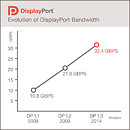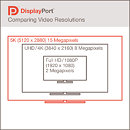Monday, September 15th 2014
VESA Releases DisplayPort 1.3 Standard, 4K at 120 Hz
The Video Electronics Standards Association (VESA) announced the release of the DisplayPort 1.3 audio / video (A/V) standard. An update to the widely used DisplayPort 1.2a standard, this latest version increases the maximum link bandwidth to 32.4 Gbps, with each of four lanes running at a link rate of 8.1 Gbps/lane-a 50% increase from the previous version of the DisplayPort standard. Allowing for transport overhead, DisplayPort's 32.4 Gbps combined link rate delivers 25.92 Gbps of uncompressed video data.
The increased bandwidth enables higher resolution monitors, including recently announced 5K monitors (with pixel resolutions of 5120 x 2880) using a single DisplayPort cable without the use of compression. It will also enable higher resolutions when driving multiple monitors through a single connection using DisplayPort's Multi-Stream feature, such as the use of two 4K UHD monitors, each with a pixel resolution of 3840 x 2160, when using VESA Coordinated Video Timing.DisplayPort 1.3 continues to support video conversion to VGA, DVI and HDMI. DisplayPort 1.3 adds support for HDCP 2.2 and HDMI 2.0 with CEC (Consumer Electronics Control), which enhances DisplayPort's utility for television applications, including 4K video with copy protection. The new standard adds support for the 4:2:0 pixel structure, a video format commonly used on consumer digital television interfaces, which enables support for future 8K x 4K displays.
DisplayPort 1.3 also enhances DisplayPort's value for multi-function interfaces that combine data transport, A/V transport and other capabilities on a single cable. It further refines protocols that enable DisplayPort to share a single cable with other data types. With its higher 8.1 Gbps per-lane link rate, DisplayPort 1.3 can support a single UHD monitor with 60Hz refresh and 24-bit color over two lanes, while assigning the remaining two lanes to increase capacity for alternate data types, such as SuperSpeed USB data, as allowed in DockPort. DisplayPort is the A/V transport standard used by DockPort, Thunderbolt and other wired and wireless multi-function interface standards.
"While becoming a mainstream video standard, DisplayPort continues to be at the cutting edge of A/V transport," said VESA Board of Directors Chair Alan Kobayashi, Fellow & Executive R&D Management for DisplayPort Group at MegaChips Technology America. "These new enhancements to DisplayPort will facilitate both higher resolution displays, as well as easier integration of DisplayPort into multi-protocol data transports, which will satisfy consumer's desire for simplicity and ease-of-use."
The DisplayPort standard is offered to VESA members without any license fee.
The increased bandwidth enables higher resolution monitors, including recently announced 5K monitors (with pixel resolutions of 5120 x 2880) using a single DisplayPort cable without the use of compression. It will also enable higher resolutions when driving multiple monitors through a single connection using DisplayPort's Multi-Stream feature, such as the use of two 4K UHD monitors, each with a pixel resolution of 3840 x 2160, when using VESA Coordinated Video Timing.DisplayPort 1.3 continues to support video conversion to VGA, DVI and HDMI. DisplayPort 1.3 adds support for HDCP 2.2 and HDMI 2.0 with CEC (Consumer Electronics Control), which enhances DisplayPort's utility for television applications, including 4K video with copy protection. The new standard adds support for the 4:2:0 pixel structure, a video format commonly used on consumer digital television interfaces, which enables support for future 8K x 4K displays.
DisplayPort 1.3 also enhances DisplayPort's value for multi-function interfaces that combine data transport, A/V transport and other capabilities on a single cable. It further refines protocols that enable DisplayPort to share a single cable with other data types. With its higher 8.1 Gbps per-lane link rate, DisplayPort 1.3 can support a single UHD monitor with 60Hz refresh and 24-bit color over two lanes, while assigning the remaining two lanes to increase capacity for alternate data types, such as SuperSpeed USB data, as allowed in DockPort. DisplayPort is the A/V transport standard used by DockPort, Thunderbolt and other wired and wireless multi-function interface standards.
"While becoming a mainstream video standard, DisplayPort continues to be at the cutting edge of A/V transport," said VESA Board of Directors Chair Alan Kobayashi, Fellow & Executive R&D Management for DisplayPort Group at MegaChips Technology America. "These new enhancements to DisplayPort will facilitate both higher resolution displays, as well as easier integration of DisplayPort into multi-protocol data transports, which will satisfy consumer's desire for simplicity and ease-of-use."
The DisplayPort standard is offered to VESA members without any license fee.


13 Comments on VESA Releases DisplayPort 1.3 Standard, 4K at 120 Hz
so short a few gbit/s, 144 Hz might be possible with some encoding scheme that doesn't use 24 bits per pixel
3840 x 2160 x 3 (bytes per pixel) x 120 (Hz) x 8 (bits per byte) = 23,887,872,000 Gbit/s
120 Hz is fine.
5120 x 2880 x 3 (bytes per pixel) x 8 (bits per byte) = 353,894,400 Mbit per frame, so roughly 73 FPS at 5K
And is this really the best bandwidth they could manage or do they just relish in introducing new versions? This, SATA, HDMI, always seem to do the bare minimum.
5k will always be an unusual resolution.
Dell is making a 5K, we need standards to catch up to where we can go before the mass market will buy into any new standards.
to access groups of 24 bits you'd have to perform a lot of work for each pixel on the cpu to extract the right bits, and sometimes do two memory transfers just to get one pixel (when it sits across the boundary of a 64-bit memory address). so for performance reasons, usually, a 24 bit graphics pixel still uses 32 bits of memory
obviously the monitor doesn't need transparency, so 24 bit over the wire is enough. internally i'd expect monitors to use 32-bits for each pixel again, just because it's so much faster and easier to access